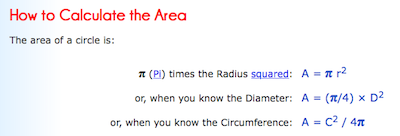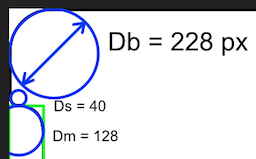 Remember last week when we played Which Screen is Bigger, iPhone 8 Plus or X? AKA Fun with Geometry? I went through, in rather excruciating detail, how to calculate the size of the screen on the iPhone X vs the iPhone 8 Plus.
Remember last week when we played Which Screen is Bigger, iPhone 8 Plus or X? AKA Fun with Geometry? I went through, in rather excruciating detail, how to calculate the size of the screen on the iPhone X vs the iPhone 8 Plus.
I wrote it up as a blog post, and Steve (also an engineer) checked all of my math before I posted it. The blog post was up for two days, when many of you read it.But then on Sunday I read it out loud as part of the NosillaCast. And on Monday, Quazim and Jill both wrote to me telling me of an idiotic error on my part. Remember when I calculated the area of the circles, subtracted them from squares and such to take into account the roundy corners of the iPhone X?
I said that the area of a circe is πD. As Quazim so eloquently posted on the blog, “My maths is rusty… but I thought the area of a circle is pii * radius (squared) and not pii * diameter, which is what you used here.”
Can you believe I did that? Can you believe Steve missed it in his careful checking? Can you believe none of you who read the blog post caught it either? One of the reasons I do the blog posts is that so you guys can catch dumb things I say before it’s in the podcast!
Yes, I’m throwing everyone under the bus with me on this one!
I was so appalled at myself that I punished myself. I went back to my drawing and made the line thicknesses much thinner so I could zoom in super tight and get the circles exactly spot on the vector drawing from Apple.
That’s when I discovered another mistake in Victor H’s explanation on iphonearena.com. He used a drawing from someone else to do his calculations. However, the radius shown for the big round corners is way off. It doesn’t matter for Victor’s calculations though because I’m still convinced he used wildly wrong pixel dimensions for the iPhone 8 Plus screen so he’s way off anyway.
Now here’s the funny thing. My calculations didn’t change all that much when I used the correct equations for the circular areas. I’ve redone the blog post (admitting there that I messed up too), and the iPhone 8 Plus still has a bigger screen area in square inches than the iPhone X, but it’s much closer than it was. The iPhone 8 Plus is less than 1% bigger than the iPhone X.
I’m embarrassed beyond belief (that’s why it took me two days to admit it to you) and I sure hope there’s no more mistakes in here! If there are, please tell me before Sunday???


Here is my teapot, short and stout –
or long and skinny like X not out
At least YOUR math error didn’t cost $125 million.
October, 1999: NASA lost its $125-million Mars Climate Orbiter because spacecraft engineers failed to convert from English to metric measurements when exchanging vital data before the craft was launched, space agency officials said Thursday.
A navigation team at the Jet Propulsion Laboratory used the metric system of millimeters and meters in its calculations, while Lockheed Martin Astronautics in Denver, which designed and built the spacecraft, provided crucial acceleration data in the English system of inches, feet and pounds.
George, that reminds me of the “Gimli Glider.” Google it for a really gripping story that largely occurred because of a similar imperial/metric blunder.
But it more closely resembles a story I read many, many years ago about a rocket that, after reaching significant altitude, proceeded to flip over and power dive into the sea. The issue was tracked down to a single errant minus sign in the guidance code. There are bugs and there are BUGS.
It proves one unassailable fact. You and Steve really are imperfect humans like all of us :):)
I think we can all forgive you both, and thank you for being you!
Barry
Awe, thanks Barry!
George, that example was a story I told my children repeatedly as they were learning math. Check your units! The other thing was to look at the answer and see if it made sense. In this case, it came very close to the other guy’s so I thought it was right. Turns out his was wrong too.
Oh well.
Ah, “Bugs” A retired friend actually overlapped time with Admiral Grace Hopper.
““Moth found trapped between points at Relay # 70, Panel F, of the Mark II Aiken Relay Calculator while it was being tested at Harvard University, 9 September 1947.
The operators affixed the moth to the computer log, with the entry: “First actual case of bug being found”. They put out the word that they had “debugged” the machine.”
“In 1988, the log, with the moth still taped by the entry, was in the Naval Surface Warfare Center Computer Museum at Dahlgren, Virginia.”
Quotes from Wired: 12 09 13: Google Honors Grace Hopper . . . and a “Bug”
Allister, the Gimli Glider story is extraordinary. Way back someone tried to teach me, “Jets glide . . . . like rocks.” so I’ll be careful to check the fuel gauge, maybe do a tank dip, next time I roll out my vintage Starfighter.
My father told me a story of when he was flying, I think it was back from South East Asia to New Zealand. With their limited range they had to make a number of stops for fuel and overnighted at some of those. They arrived at such a stop where they would overnight before embarking the next day on an overwater flight pretty much at the limit of their range.
After landing and securing the aircraft, one of the crew went over to the base refuelers and gave the paperwork for the fuel to be loaded. Then they headed off to get a feed and some rest.
In the morning as they prepared the aircraft, the one of the crew hopped up on the wing and placed a dipstick in the tank. The tank should have been brimmed but clearly was not. A discussion was had with the refueler who insisted he had loaded the requested amount. Before long they figured the problem. As was customary when operating in areas where US forces’ presence was significant (they were flying in and out of Vietnam for many missions) they had specified the fuel load in US gallons, but the local refueler had read those as imperial gallons (for a British manufactured aircraft). When you ask for 100 US gal, and you’re given 100 Imp. gal, you only get about 83 US gal.
Had they relied on the paperwork, they would have taken off without enough fuel to reach their destination. Whether they would have believed the fuel gauges is another matter – they had been known to malfunction on occasion. Had they trusted entirely in the paperwork, it is likely the paperwork would have been lost in the sea along with the aircraft and it’s crew and payload.
So it’s not just converting to and from metric that can cause problems!
First of all, it is GOOD for a person to admit to his mistake. and that is Math, a negative sign in a numerical calculation can send you to the wrong decision, what about changing a rule in math like the area of a circle which is pi r squared to its circumference which is pi times the diameter of a circle!